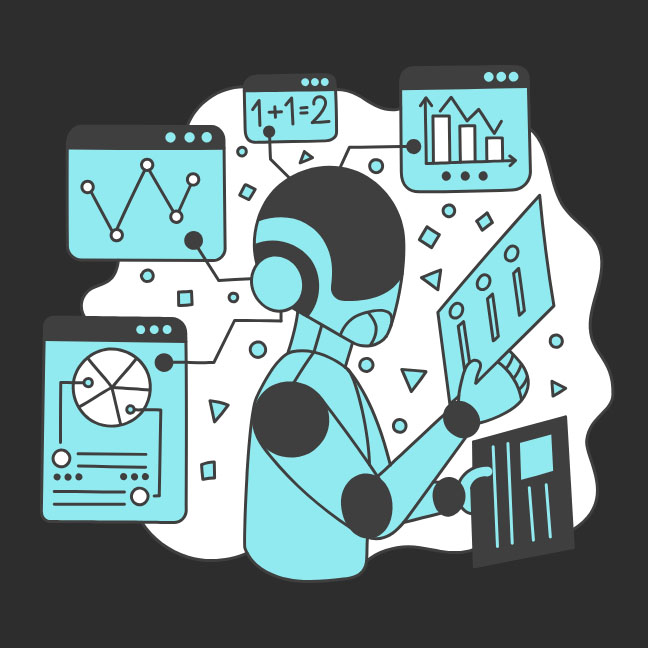Artificial Intelligence, zBlog
How to Build an AI App: A Step-by-Step Guide for 2026
trantorindia | Updated: July 30, 2025
Artificial Intelligence continues to reshape the technology landscape, and knowing how to build an AI app has become vital for businesses and developers alike. As of 2026, developing effective AI-powered applications requires not only technical expertise but also a strategic understanding of data, AI models, emerging tools, and user experience demands. This guide provides a comprehensive step-by-step roadmap to successfully build an AI application, enriched with insights on the latest trends, tools, and best practices that define AI development today.
The question of how to build an AI app is central to the innovation goals of many organizations in 2026. With AI technologies more accessible and powerful than ever, the barrier to entry has lowered—but complexity remains. Building an AI app is more than embedding a model into software; it requires a full lifecycle approach that spans understanding user needs, data management, model selection, deployment, and ongoing monitoring.
This guide incorporates proven strategies and state-of-the-art AI tools to help you successfully navigate building an AI app that delivers real-world value while remaining scalable and compliant.
Step 1: Define Clear Objectives and Use Cases
Successful AI applications start with clear, measurable objectives. Ask yourself:
- What problem will the AI app solve?
- Who are the intended users?
- What business impact or user benefit should it deliver?
In 2026, AI apps commonly focus on automating complex tasks, delivering hyper-personalization, improving decision-making, or enhancing productivity through AI agents or assistants. Defining the use case at the start aligns your team and resources.
Examples:
- Automating document processing for finance teams
- Personalized real-time health monitoring guidance
- Intelligent content recommendation engines
Aim to frame objectives in measurable terms, such as “reduce customer service response time by 40%” or “increase upsell conversions by 15% with AI-driven offers.”
Step 2: Conduct Market and Competitor Research
Understanding the competitive landscape and market trends is crucial. Analyze existing AI apps that address similar use cases. Key points include:
- Strengths and weaknesses of competitor products
- Gaps in user experience or feature sets you can address
- Emerging customer demands or regulations influencing AI adoption
This research helps position your AI app uniquely and anticipate challenges.
Step 3: Assemble the Ideal AI Project Team
Building an AI app involves a multidisciplinary team including:
- AI/ML Engineers and Data Scientists: Architect and train models.
- Data Engineers: Manage data pipelines and preprocessing.
- Software Developers: Build front-end and back-end components.
- UX/UI Designers: Craft intuitive, accessible interfaces.
- Product Managers: Align vision and delivery.
- Quality Assurance Specialists: Ensure robustness and reliability.
- Ethics and Compliance Experts: Oversee responsible AI use.
Blending diverse expertise, including domain specialists, improves both technical accuracy and user experience, especially as AI applications become more complex.
Step 4: Data Collection, Labeling, and Enrichment
Data remains the lifeblood of AI apps. Steps include:
- Sourcing Data: Use internal systems, public datasets, or third-party providers. Ensure data relevancy to your use case.
- Data Cleaning: Remove errors, duplicates, and inconsistencies.
- Labeling Data: For supervised AI models, accurate labeling is critical. Semi-automated tools and crowdsourcing help scale this process in 2026.
- Data Augmentation: Techniques such as synthetic data generation reduce dependency on real labeled data, especially for edge cases.
- Privacy and Compliance: Follow regulations like GDPR and CCPA to protect user data rights.
The increasing availability of self-supervised learning techniques in 2026 eases label dependency but maintaining data quality still underpins AI success.
Step 5: Choose the Right AI Models and Algorithms
Choosing the appropriate AI model depends on the problem type and data characteristics:
- Supervised learning models for labeled prediction tasks (classification, regression).
- Unsupervised learning for discovering patterns, clustering, or anomaly detection.
- Reinforcement learning for decision-making where learning is guided by rewards.
- Self-supervised learning, a rising trend, enables models to learn from vast unlabeled data with minimal supervision.
Consider pretrained foundation models, such as advanced large language models, vision transformers, or multimodal AI that combine text, image, and audio understanding. Transfer learning reduces the need for enormous datasets while boosting accuracy.
Step 6: Select Development Frameworks and Platforms
In 2026, these are the leading frameworks supporting AI app development:
Low-code/no-code AI platforms also grow, enabling business users to build AI apps faster while integrating with APIs such as OpenAI’s or proprietary systems.
Cloud services simplify deployment, scaling, monitoring, and continuous training workflows.
Step 7: Build a Prototype and Minimum Viable Product (MVP)
Create a functioning prototype focusing on core AI capabilities. The MVP approach enables:
- Rapid user feedback collection
- Early validation of AI accuracy and usability
- Iterative improvements before costly scaling
Adopt agile methodologies and continuous integration/continuous deployment (CI/CD) pipelines to speed iterations.
Step 8: Design User Experiences for AI Apps
User experience is paramount for AI app adoption:
- Communicate AI decisions transparently with explanations and confidence levels.
- Offer human-in-the-loop controls for critical decision points.
- Utilize conversational UIs, voice commands, and multimodal interactions, now widely expected in 2026.
- Facilitate personalization leveraging AI’s adaptive capabilities.
Smooth, trustworthy, and accessible UX underpins user trust and engagement.
Step 9: Train, Fine-tune, and Integrate AI Models
Train models with your curated datasets—fine-tuning foundation models when applicable. Monitor training for bias, overfitting, or data drift.
Integration involves embedding models within your app architecture with proper APIs and microservices, ensuring responsiveness, reliability, and security.
Optimize for on-device AI when latency or privacy concerns arise, supported by edge AI advancements.
Step 10: Test, Validate, and Ensure Ethical AI
Testing is multi-dimensional:
- Functional Testing: Validate AI outputs against expected results.
- Performance Testing: Confirm response times and stability under load.
- Bias and Fairness Testing: Audit output fairness across user groups to prevent discrimination.
- Security Testing: Safeguard against adversarial attacks and data breaches.
Ethical compliance and transparency are now mandated by industry standards and regulations.
Step 11: Deploy, Monitor, and Iterate Your AI App
AI app deployment uses CI/CD and containerization technologies (e.g., Kubernetes). Post-launch:
- Continuously monitor key performance indicators (KPIs) such as accuracy, latency, and user satisfaction.
- Set up alerts for anomalies or data drift that could degrade model performance.
- Collect user feedback for app improvements.
- Retrain and update models regularly to keep them relevant.
Modern observability platforms unify logs, metrics, and model explainability dashboards for proactive management.
Key Trends in AI App Development in 2026
- Foundation Models Explode: AI apps leverage very large multimodal models trained on diverse datasets for text, images, audio, and video.
- Self-Supervised and Unsupervised Learning: Dramatically reduce requirement for labeled data, expanding AI app feasibility in niche domains.
- Augmented AI: AI agents augment human workflows rather than replace them, blending automation and human intelligence.
- Edge and Federated AI: Privacy-preserving, decentralized AI processing gains urgency in sensitive sectors (healthcare, finance).
- AI Governance and Ethics: Regulation mandates transparency, bias mitigation, and ethical risk management. AI explainability tools gain widespread use.
Avoiding Common Pitfalls
- Neglecting data quality and preparation can cripple AI accuracy.
- Over-engineering MVP features delays validation and wastes resources.
- Ignoring user experience compromises adoption.
- Neglecting ethical testing invites regulatory fines and reputation damage.
- Underestimating cloud infrastructure and retraining costs leads to budget overruns.
Conclusion: Partnering with Trantor Inc for AI Success
Knowing how to build an AI app in 2026 means combining strategic vision with technical excellence at every step—from data to deployment. At Trantor Inc, we understand these demands deeply. We partner with businesses to deliver scalable AI solutions, blending generative AI, machine learning, and cloud innovation to unlock transformative value.
Whether you are just getting started or looking to scale AI-powered products, our expert teams provide end-to-end AI services tailored to your industry and goals. Explore our offerings in Artificial Intelligence, Generative AI Solutions, and Machine Learning.
Contact us today to turn your AI app vision into reality — together, let’s build the future.



